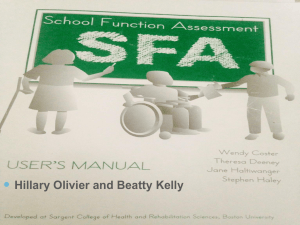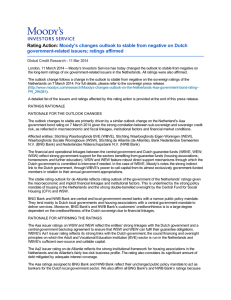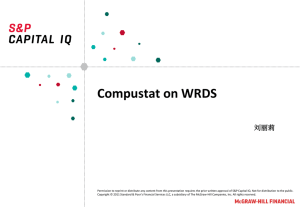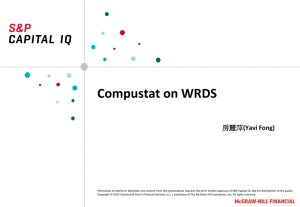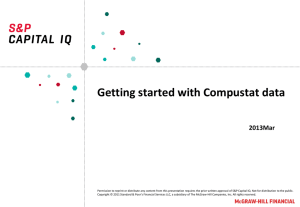Western European Bank Ratings And Outlook Banking Union
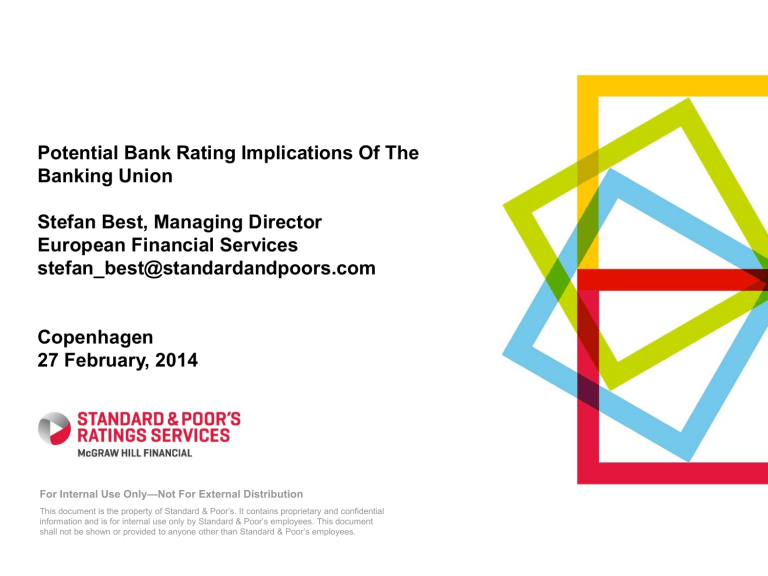
Potential Bank Rating Implications Of The
Banking Union
Stefan Best, Managing Director
European Financial Services stefan_best@standardandpoors.com
Copenhagen
27 February, 2014
For Internal Use Only —Not For External Distribution
This document is the property of Standard & Poor’s. It contains proprietary and confidential information and is for internal use only by Standard & Poor’s employees. This document shall not be shown or provided to anyone other than Standard & Poor’s employees.
2
Agenda
•
Topics:
Western European Bank Ratings And Outlook
Banking Union: Potential Rating Implications
Conclusion
Western European Bank
Ratings And Outlook
4 All data as at: 01/02/14
5 All data as at: 01/02/14
6 All data as at: 01/02/14
7
We See the Following Credit Trends
• Deleveraging and restructuring to continue
• Potential for further large credit impairments
(weak economy and upcoming asset quality review and stress tests)
• Earnings pressure will persist (weak economy, low interest rates, deleveraging, restructuring, litigation, regulatory changes)
• Initiatives to reduce funding gaps and repay
ECB LTROs
• Capital strengthening
• Adapt to evolving bank resolution legislation
Banking Union:
Potential Rating Implications
9
Determining the Ratings – Key Steps
Banking Union Update
Initiative
Single rule book
Objective
Uniform application of Basel 3 in all member states
Status
Approved
Effective Jan. 2014
Single Supervisory
Mechanism
Common supervision of the about 130 largest banks in the euro area but open to all EU member states
Approved
Effective Nov. 2014
Single Resolution
Mechanism and
BRRD
•
Align supervision and resolution at central level
• Create single resolution fund (SRF)
•
Comon legislation on bank resolution (BRRD)
•
To be agreed on before the elections in
May 2014
• BRRD/SRM effective by Jan. 2015
•
Bail-in tool Jan. 2016?
Direct bank recapitalization through
ESM
Provide financial backstop besides SRF
Common Deposit
Guarantee Scheme
Strengthen customer confidence and stability of banks' funding bases
Requires finalization of BRRD/SRM
Progress uncertain
Structural Reform
Measures
10
EU „Too-big-too-fail banks“:
•
Reduce risk of failure
• Facilitate bank resolution
•
Ease monitoring and supervision
•
EC Proposal on Jan 29, 2014
• Prop trading ban Jan. 2017?
• Separation other trading July 2018?
Comprehensive Assessment By The ECB
•
The ECB will conclude its assessment in October 2014
•
Scope:
Supervisory risk assessment: liquidity, leverage, funding
Asset quality review: all asset classes (valuation, provisioning)
Stress test: no details on methodology/scenarios provided
•
Goals:
Greater transparency, balance sheet repair, confidence building
•
Capital thresholds: CET 1 of 8% (AQR); 5.5% (Stress test)
•
Timeline for follow up/corrective action uncertain
•
National public backstops if private sources for viable banks are insufficient
•
We believe that the review could accelerate balance sheet repair
•
We may adjust ratings for weaknesses that we have not identified yet
11
Proposed Structural Reform Measures
• Ban on prop trading for deposit taking institutions which would apply to ~30 of the biggest EU banks
W ould prohibit activities “for the sole purpose of making a profit for own account without any connection to actual or anticipated client activity” in banks that meet certain criteria and exceed a specified threshold (applicable from 1 Jan. 2017)
Would also prohibit the same banks from investing in hedge funds
• Grant supervisors the power or obligation (BRRD Art.13) to require the transfer of other high-risk trading activities such as market making, complex derivatives and securitization (applicable from 1 July 2018)
• Rules on operational links between trading entity and rest of the banking group to ensure that separation is effective
•
BRRD
– Art. 14 already gives the authorities the “powers to address or remove impediments to resolvability” (including the power to require changes to the legal or operational structures of banks)
• Likely to apply to foreign subsidiaries of EU banks and EU branches of foreign banks (exemptions possible for third country equivalence regime)
Uplift to the SACP for potential government support
“Moderately high" likelihood of extraordinary government support
• The long-term counterparty credit ratings on highly systemically important Western European banks is up to two notches higher than the SACP, reflecting our view of a “ moderately high " likelihood of extraordinary government support (up to one notch higher for moderately systemically important banks)
Source: Banks: Rating Methodology And Assumptions Nov. 9, 2011
13
Measures To Reduce Implicit Government Support
• Systemic importance, according to our criteria, is the degree to which a bank's failure affects all or parts of the financial system and the real economy of the country where the bank operates.
• We currently regard almost all top 50 Western European banks as “highly systemic”. In most cases, this leads to a 1 or 2 notch support uplift in their current rating, as well as to the ratings of their subsidiaries.
• Emerging resolution powers could have implications for the notches of government support currently included in ratings on systemically important banks
– We could re-classify governments as less supportive
– We could re-classify banks as less systemically important
– There may be specific risks associated with particular classes of debt (e.g. subordinated)
– Parental support for foreign subsidiaries and branches may be less certain
• Changes to business and financial profile could affect ratings up or down
• There may be other specific implications
– For example, in the U.S., the FDIC’s proposal for a single point of entry could affect ratings on bank holding companies
14
Measures To Reduce Implicit Government Support
• Although political consensus is emerging, obstacles for resolution remain which means that providing extraordinary government support to senior creditors in a timely fashion remains a strong possibility
Resolvability of banks: that is, the ability to stabilize a failing institution and effect an orderly wind-down
The need to preserve confidence in the banking system and support economic recovery
Common resolution tools and legislation
Sufficient longterm liabilities eligible for “bail-in”
For internationally-active banks, it remains unclear how authorities will be able to ensure coordination when executing a resolution
• We expect most Western governments to remain supportive of the senior creditors of systemic banks while economies recover and resolution regimes develop
• We will continue to review rating implications as resolution powers become more advanced and harmonized, and more banks become easily resolvable
15
Conclusion
17
New regulation, supervision, and legislation can affect bank ratings positively and negatively in multiple ways
Regulation, Supervision, Legislation:
• Single Rule Book
• Single Supervisory Mechanism
• Single resolution mechanism/BRRD
• Structural reform
• Financial backstops
Rating factors:
• BICRA: Economic and Industry Risk
• Business position:
• Stability, Diversity, Restructuring needs
• Capital & Earnings:
• Capital buffers, Operational cost,
Earnings potential
• Risk position:
• Growth, Concentration, Complexity
• Funding & Liquidity:
• Liquidity buffers; Funding mismatches;
Funding access; Asset Encumbrance
• Government support:
• Ability and willingness
• Group support: Fungibility/Ringfencing
Conclusions
• European banks are navigating in uncertain times
• The five key risks that we have identified some time ago continue dominating bank ratings
1. Weakening sovereign creditworthiness
2. Threat of economic recession or only sluggish recovery
3. Funding constraints
4. Transition to more stringent regulatory requirements
5. Changing nature of government support
• Extraordinary support has been the key stabilizing factor for many
European bank ratings
• Banking Union can affect bank ratings positively and negatively in multiple ways
• Impact depends on banks ´ business and financial profile and how banks ´ managements, authorities and market participants respond to these changes
Contact Information
Stefan Best, Managing Director
Tel. +49 69 33 999 154
Email: stefan_best@standardandpoors.com
You wish to receive information crisp and visual?
Visit http://www.understandingratings.com
to find recent research articles promoted with 5 minute video clips (CMTVs).
www.standardandpoors.com
Copyright © 2014 by Standard & Poor’s Financial Services LLC. All rights reserved.
No content (including ratings, credit-related analyses and data, valuations, model, software or other application or output therefrom) or any part thereof (Content) may be modified, reverse engineered, reproduced or distributed in any form by any means, or stored in a database or retrieval system, without the prior written permission of Standard & Poor’s Financial Services
LLC or its affiliates (collectively, S&P). The Content shall not be used for any unlawful or unauthorized purposes. S&P and any third-party providers, as well as their directors, officers, shareholders, employees or agents (collectively S&P Parties) do not guarantee the accuracy, completeness, timeliness or availability of the Content. S&P Parties are not responsible for any errors or omissions (negligent or otherwise), regardless of the cause, for the results obtained from the use of the Content, or for the security or maintenance of any data input by the user.
The Content is provided on an “as is” basis. S&P PARTIES DISCLAIM ANY AND ALL EXPRESS OR IMPLIED WARRANTIES, INCLUDING, BUT NOT LIMITED TO, ANY
WARRANTIES OF MERCHANTABILITY OR FITNESS FOR A PARTICULAR PURPOSE OR USE, FREEDOM FROM BUGS, SOFTWARE ERRORS OR DEFECTS, THAT THE
CONTENT’S FUNCTIONING WILL BE UNINTERRUPTED OR THAT THE CONTENT WILL OPERATE WITH ANY SOFTWARE OR HARDWARE CONFIGURATION. In no event shall S&P Parties be liable to any party for any direct, indirect, incidental, exemplary, compensatory, punitive, special or consequential damages, costs, expenses, legal fees, or losses
(including, without limitation, lost income or lost profits and opportunity costs or losses caused by negligence) in connection with any use of the Content even if advised of the possibility of such damages.
Credit-related and other analyses, including ratings, and statements in the Content are statements of opinion as of the date they are expressed and not statements of fact. S&P’s opinions, analyses and rating acknowledgment decisions (described below) are not recommendations to purchase, hold, or sell any securities or to make any investment decisions, and do not address the suitability of any security. S&P assumes no obligation to update the Content following publication in any form or format. The Content should not be relied on and is not a substitute for the skill, judgment and experience of the user, its management, employees, advisors and/or clients when making investment and other business decisions. S&P does not act as a fiduciary or an investment advisor except where registered as such. While S&P has obtained information from sources it believes to be reliable, S&P does not perform an audit and undertakes no duty of due diligence or independent verification of any information it receives.
To the extent that regulatory authorities allow a rating agency to acknowledge in one jurisdiction a rating issued in another jurisdiction for certain regulatory purposes, S&P reserves the right to assign, withdraw or suspend such acknowledgement at any time and in its sole discretion. S&P Parties disclaim any duty whatsoever arising out of the assignment, withdrawal or suspension of an acknowledgment as well as any liability for any damage alleged to have been suffered on account thereof.
S&P keeps certain activities of its business units separate from each other in order to preserve the independence and objectivity of their respective activities. As a result, certain business units of S&P may have information that is not available to other S&P business units. S&P has established policies and procedures to maintain the confidentiality of certain non-public information received in connection with each analytical process.
S&P may receive compensation for its ratings and certain analyses, normally from issuers or underwriters of securities or from obligors. S&P reserves the right to disseminate its opinions and analyses. S&P's public ratings and analyses are made available on its Web sites, www.standardandpoors.com
(free of charge), and www.ratingsdirect.com
and www.globalcreditportal.com
(subscription), and may be distributed through other means, including via S&P publications and third-party redistributors. Additional information about our ratings fees is available at www.standardandpoors.com/usratingsfees .
20




